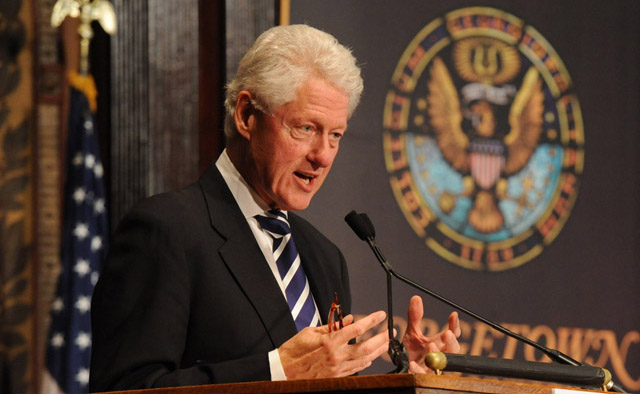On Friday afternoon, former President Bill Clinton and a stable of former cabinet secretaries and economic advisors from his Administration descended on Georgetown to participate in a wide-ranging discussion focusing on the economic policies of the 1990s and their relevance to today’s economy. The former President was joined on stage by Robert Rubin, Erskine Bowles, Gene Sperling, John Podesta, Laura Tyson, and a handful of other Democratic luminaries, in an event that had all the warmth of an (unusually prestigious) 10-year college reunion.
Reflecting at length on the economic and political trends of the past 30 years, President Clinton argued that current levels of inequality are unsustainable. He defended the economic policies of the Obama Administration as a return to the central principle of his own terms in office: Investing in the future to promote shared prosperity. The former President took particular issue with the notion (first articulated by President Reagan) that “government is the problem”. He attacked the “voodoo economics” of the Reagan and George W Bush years and an economic philosophy that puts tax-cuts for the wealthy ahead of balancing the budget.
In recent years, the Clinton era has become so strongly associated with surpluses and high job growth that it is easy to forget that Mr. Clinton inherited a bad economy, with unemployment hovering near 7% . The projected budget deficit of $300 billion was a big number by the standards of the day. According to President Clinton, economists in the early nineties converged around the idea of coupling long-term deficit reduction with short-term steps to boost demand and spur growth, just as they have in recent years. But actually accomplishing this was no simpler then than it is now. Like the more recent stimulus package, the 1993 Deficit Reduction Act (which included a handful of political winners, including an increase in the gas tax) was passed with essentially no votes to spare; indeed, many Democrats (including panelist Marjorie Margolies) lost their seats in Congress as a result of their “yes” votes. Fortunately for President Clinton, the broader economic trends of the 1990s were far more positive than those of the present era, allowing him to take credit for the ultimate success of his policies. Mr. Obama may not be so lucky.
Despite the obvious parallels, President Clinton himself noted that there are important differences between the early 1990s and the economic situation today. For example, the interest rate on 10-year federal bonds was 7% in 1992, while today it is below 2%. When Mr. Clinton took office, the bond market was worried about projected deficits, and the former President described the decision to raise taxes and cut spending in this context as a “gamble” designed to lower interest rates and stimulate investment.
Similarly, in the presentations that preceded President Clinton’s address many of his former staff stressed the importance of restoring “confidence” to the markets, an ironic term given its current political implications. In recent years, famed Princeton economist Paul Krugman has devoted a substantial amount of ink to arguing against the existence of a “Confidence Fairy” that will magically restore growth once federal spending is reduced. Of course, Mr. Krugman is referring primarily to business confidence and not the bond market, and slashing discretionary spending in the current fiscal year is not equivalent to long-term deficit reduction; so it’s not clear that this “lesson” from the Clinton years can be applied to the current context.
Towards the end of his speech, Mr. Clinton offered his support for a grab-bag of recently enacted or recently proposed policies, from the trade deals with Colombia and South Korea, to the proposed “infrastructure bank,” to the recommendations of the Simpson-Bowles Deficit Commission. He lauded the Obama Administration’s focus on green technology, while lamenting the failure of his own “energy tax” which he pointed out was essentially a carbon tax by a different name.
Listening to President Clinton and his team, I was struck by how little has changed since Mr. Clinton’s inauguration twenty years ago. Despite two major wars, a massive recession, the rise of China and the Internet, and numerous other developments, foreign and domestic, it seems that we are still fighting the same old partisan battles; we are still struggling to raise enough revenue to meet the demands of governing, still looking for better ways to educate our kids, protect the environment, and rebuild the middle class that our parents remember. Perhaps we should be sobered by our lack of progress. Or perhaps these challenges are by their very definition enduring, never to be fully overcome. Either way, we’ve been here before.
Established in 1995, the Georgetown Public Policy Review is the McCourt School of Public Policy’s nonpartisan, graduate student-run publication. Our mission is to provide an outlet for innovative new thinkers and established policymakers to offer perspectives on the politics and policies that shape our nation and our world.

